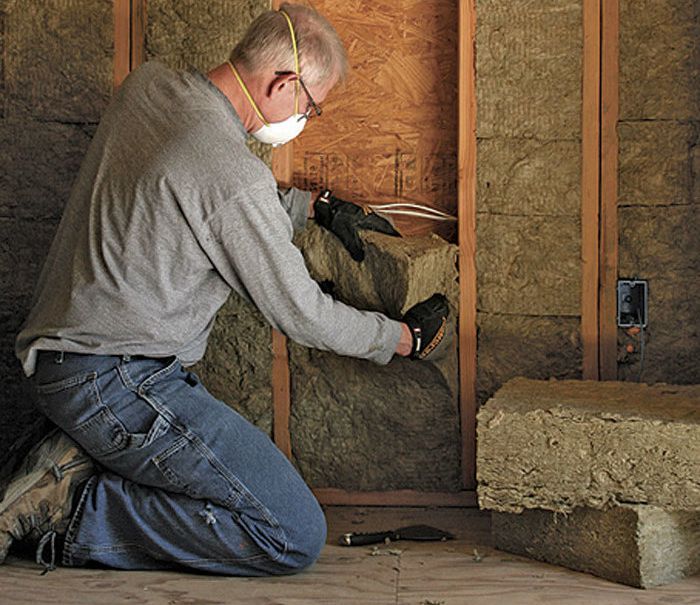“Warm and Fluffy” Insulation
Builder Andy Engel ruminates on the recycled content and carbon burden of fibrous insulations.

When it comes to fluffy insulation, I’m a bit of an agnostic. I’ve used most types out there, except for denim. Installed properly, most insulations have their place. However, the question of embodied energy and the hidden carbon burden that so often accompany insulation nags me. The more I think about it, the more I think we should be using more cellulose insulation and less of everything else. Cellulose has the effect of sequestering carbon, meaning that it can actually reduce the amount of CO2 in the atmosphere. That said, it’s not a practical choice everywhere, particularly on the smaller jobs.
That line of thinking led me to YouTube yesterday morning because I got to wondering about how the manufacturing process worked for different kinds of fluffy insulation. That led me down several rabbit holes. I wanted to know how manufacturing affects their carbon burdens; and climate change and the potential end of life on the planet notwithstanding, the manufacturing processes are fascinating on their own.
Recycled content
The manufacture of both fiberglass and mineral wool are energy intensive. Both materials begin, essentially, as rock. Fiberglass starts as sand and soda ash. Blended and melted together, it becomes glass. The glass used in fiberglass has a high content of recycled material, around 50%. Most of that is industrial scrap, however. For example, about 20% of the recycled material Johns Manville uses is post-consumer. Still, industrial scrap or post-consumer waste, recycled content is hard to complain about.
Mineral wool is similar in that it, too is, wait for it, mineral-based. Mineral wool has an even higher recycled content than fiberglass, about 75% being post-industrial material such as blast furnace slag.
So, while that’s all well and good, cellulose beats both rock-based insulations in terms of recycled content. It’s about 85% recycled material.
Denim insulation also has a high recycled content, about 80%. Made mostly from old blue jeans because blue jeans are one of the few types of garment that are reliably made from 100% cotton, denim blue might be the new green. Sorry, couldn’t resist. And like cellulose, because cotton is plant-based, recycling it sequesters carbon. However, farming it is very intensive and may cause its own environmental damage. Still, we gotta do something with our old jeans. An added benefit of recycling old jeans into insulation is the possibility that charitably donating our used clothes to organizations that export them to developing countries has the perverse economic effect of damaging local clothing manufacture in those places.
Carbon burden is surprising
Both fiberglass and mineral wool require the raw materials to be heated to their melting point. In both cases, that’s around 2500℉. This is obviously an energy-intensive process, although mineral wool manufacturers claim the payback period in use is only a month or so. Mineral wool’s cradle-to-grave embodied energy, according to Greenspec, is 16.8 MJ/kg. Fiberglass’s is even higher, at 49.6 MJ/kg. Those numbers actually compare relatively favorably to cellulose, with an embodied-energy content of 16.64MJ/kg (some sources say one quarter of that number).
Of course, the installed density of the insulations affect the real numbers. Mineral wool is installed at a density of around 1.7lbs/cf, while fiberglass is around half of that. Dense-pack cellulose is installed at around 4lbs/cf.
I couldn’t find embodied-energy information on denim insulation. In short though, the embodied-energy content in any of these insulations isn’t dramatically different.
Actually making the stuff
My favorite school field trip was when Buggy McHale took my high-school chemistry class to Bethlehem Steel, and we got to stare into a heat of steel melting in a basic oxygen furnace. I’m not kidding when I say this was one of the highlights of my life. Iron melts at a similar temperature as glass or rock, so the theatrics of the process fascinate me.
Making the insulation is similar with both fiberglass and mineral wool. The molten material is fed into a kind of colander that swings back and forth, spewing threads of mineral or glass fibers. The tangle of fibers is mixed with a binder, then formed and compressed into ribbons of material that are the desired width and density. Chopped to batt-length and stacked, the batts are compressed for packaging and bagged.
Cellulose is comparatively boring. Scrap paper and cardboard is dumped on a factory floor, stirred up a bit, and fed into big hammer mills . Once masticated by the hammer mill, the pulp is mixed with boric acid for fire and pest resistance. Because cellulose is always designed to be blown, there’s no step that converts it to batts. It’s just bagged up and shipped.
Denim is produced with processes that bear similarities to both cellulose and mineral or glass insulation. It’s shredded in a way that resembles the milling of cellulose, with the added step of running under a magnet that removes zippers and buttons. Then it’s mixed with a binder and formed into batts. One difference is that cotton fibers are much tougher than glass or mineral fibers, so cutting denim insulation on site is challenging. Some manufacturers pre-slice denim insulation to ease installation.
In the big picture, which insulation you use probably isn’t as important as installing it correctly. Of the ones I’ve talked about, cellulose is easiest. You call a pro and have them blow it in. Of the batts, I haven’t used denim. Between fiberglass and mineral wool, I’ll choose mineral wool every time. Its higher density and stiffness makes it much easier to cut accurately and to fit in place. Heck, I like it so much a picture of me installing it once graced the cover of Fine Homebuilding magazine.
_________________________________________________________________________
This article originally appeared in Green Building Advisor.
Fine Homebuilding Recommended Products
Fine Homebuilding receives a commission for items purchased through links on this site, including Amazon Associates and other affiliate advertising programs.

Disposable Suit

Nitrile Work Gloves

Staple Gun

